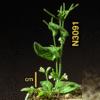Search result for 'flower photo '.
Viewing records 11 to 20 of 40 hits.
previous
|
1
|
2
|
3
|
4
|
next
|
N3091
|
Name: Terminal flower |
Price:
£11.00
|
Donor
- Monash University David Smyth
|
Locus
|
Photo

|
Stock type: individual line
|
Material type: seed
|
|
Description
Form
|
Phenotype
Inflorescence apices terminate early with complex multiple flower.
|
|
N3159
|
Name: Redei line |
Price:
£11.00
|
Donor
- University of Missouri George Redei
|
|
Photo

|
Stock type: individual line
|
Material type: seed
|
|
Description
Form, Flowering
|
Phenotype
somewhat determinate inflorescences,increased number of rosette inflorescences, looks like terminal flower (tfl); multiple fruits, short plants.
|
|
N3255
|
Name: 27-325 |
Price:
£11.00
|
Donor
- University of Missouri George Redei
|
|
Photo

|
Stock type: individual line
|
Material type: seed
|
|
Phenotype
flabellata, inflorescence mutant, flower disposition resembles a fan shape.
|
|
|
N3768
|
Name: 35S::AP1 |
Price:
£11.00
|
Donor
- University of California, San Diego Martin Yanofsky
|
|
Photo

|
Stock type: individual line
|
Material type: seed
|
|
Description
35S::AP1 (line 563.CI1.5)
|
Phenotype
semidominant; plants flower significantly earlier than wt under both continuous light (CL) and short day (SD); after producing 5 to 8 total leaves, the primary shoot meristem of a CL-grown plant is transformed into a compound terminal flower, secondary shoot meristems produced in the axils of cauline and rosette leaves are usually converted into solitary flowers, although partial shoot-to-flower conversions can be seen in some basal positions; under SD conditions plants produce about 18 total leaves before begining to produce flowers, shoot to flower transformations of CL grown plants are largely atenuated by short photoperiods.
|
|
N3812
|
Name: xtc1-1 |
Price:
£11.00
|
Donor
- University of Pennsylvania Scott Poethig
- University of Pennsylvania Laura Conway
|
Locus
|
Photo

|
Stock type: individual line
|
Material type: seed
|
|
Description
extra cotyledon
|
Phenotype
first one or two leaves transformed into cotyledons (smaller than cotyledons, often irregular in shape, have few or no trichomes and have a simple venation pattern); true cotyledons often misshappen; small rosettes; reduced plant height; inflorescence stem lacks epicuticular wax (cer phenotype); flower buds open prematurely; reduced female fertility; delayed embryogenesis at globular-to-heart transition .
|
|
N6165
|
Name: apetala |
Price:
£11.00
|
Donor
- University of California, Davis John Bowman
|
Locus
|
Photo

|
Stock type: individual line
|
Material type: seed
|
|
Phenotype
strong apetala. strong allele; homeotic conversion of sepals (first whorl) to bracts, secondary or tertiary flowers are formed in the axils of the transformed sepals; petals (second whorl) usually absent but are occasionally replaced by stamens or petal-stamen-bract-like mosaic; phenotype varies acropetally, with more complete flower-to-inflorescence conversions in basal flowers and at low temperature Phenotype curated by ABRC
|
|
|
N6167
|
Name: glabra, terminal flower |
Price:
£11.00
|
Donor
- University of Oregon Ry Meeks-Wagner
|
Locus
|
Photo

|
Stock type: individual line
|
Material type: seed
|
|
Phenotype
early flowering; determinate inflorescence with terminal compound floral structure consisting of 2 or 3, sometimes incomplete, flowers; more severe phenotype at higher temperatures and longer photoperiods; lacks trichomes on stems and leaves.
|
|
|
N6230
|
Name: apetala |
Price:
£11.00
|
Donor
- University of British Columbia (UBC) George Haughn
|
Locus
|
Photo

|
Stock type: individual line
|
Material type: seed
|
|
Phenotype
strong allele; homeotic conversion of sepals, organ types vary from no leafy to lateral organs missing or filamentous with axial organs being sepal-carpels; many secondary or tertiary flowers are formed in the axils of transformed sepals; second whorl develops into stamens, stamen-petals or filaments; in the third whorl, organs in lateral positions are consistently missing, and numbers of axial organs are reduced, or may also form stamen- carpel organs; occasionally the carpels (fourth whorl) may remain unfused or be replaced by a number of stamens; reduced fertility with stamens shedding little pollen, and ovules appearing to degenerate; phenotype varies acropetally, with more complete flower-to-inflorescence conversions in basal flowers and at low temperature.
|
|
|
N6231
|
Name: apetala |
Price:
£11.00
|
Donor
- University of British Columbia (UBC) George Haughn
|
Locus
|
Photo

|
Stock type: individual line
|
Material type: seed
|
|
Phenotype
intermediate allele; homeotic conversion of sepals, organ types found vary from leaf-like, to leaf-carpel, to sepal- carpel intermediate organs or small filaments; some secondary or tertiary flowers are formed in the axils of the transformed sepals; second whorl typically forms stamens, although filaments, petal-stamens or petal-sepals may also develop; third whorl is often missing the lateral stamens, and the number of axial stamens is reduced; fourth whorl may develop a multicarpellate pistil; phenotype varies acropetally, with more complete flower-to-inflorescence conversions in basal flowers and at low temperature.
|
|
|
N6232
|
Name: apetala |
Price:
£11.00
|
Donor
- University of British Columbia (UBC) George Haughn
|
Locus
|
Photo

|
Stock type: individual line
|
Material type: seed
|
|
Phenotype
weak allele; homeotic conversion of sepals, organ types found vary from leaves, to leaf-sepal intermediate organs and to sepals and sepal-carpels; few secondary or tertiary flowers are formed in the axils of transformed sepals; second whorl organs form petals or filaments, or rarely petal-stamens and stamens; third whorl with organs in the position of lateral stamens commonly missing and organs in axial positions usually form stamens; phenotype varies acropetally, with more complete flower-to-inflorescence conversions in basal flowers and at low temperature.
|
|
previous
|
1
|
2
|
3
|
4
|
next
